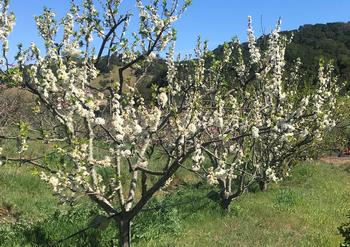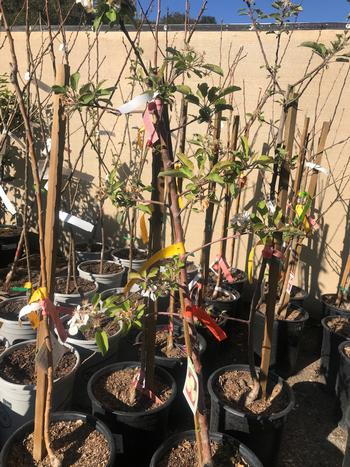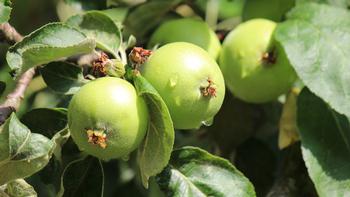Give new fruit trees a good start
-
Marty Nelson
-
Who doesn’t love fruit trees? They are nature’s best multitaskers. They provide us food, shade and cool us, beautify our surroundings, attract beneficial insects and birds, and even entertain us by supplying support for swings, treehouses, and young climbers. To maximize these benefits, it’s essential to get new fruit trees off to a good start.
 Regular pruning can keep fruit trees at a size that makes later harvesting easier. Photo: Marty Nelson
Regular pruning can keep fruit trees at a size that makes later harvesting easier. Photo: Marty NelsonFirst, select the right tree for the right location. That apple tree you remember from your grandmother’s backyard in Iowa may not be a variety that will grow well in Marin. Deciduous fruit trees all require a certain number of winter chill hours (temperatures below 45o F) in order to break dormancy and produce flowers in spring. Chill hours vary among and within fruit tree types. Apples and pears, for example, generally need 1200-1500 chill hours, but low chill varieties are available. A table showing the chill requirements for popular fruit trees can be found at homeorchard.ucanr.edu.
Your garden microclimate determines the best location for fruit trees. They require a minimum of 8 hours of sunlight daily, good soil drainage, and regular irrigation. Consider the size of the trees and the spacing needed to avoid competition for light and nutrients. Standard or semi-dwarf trees have better fruit production than dwarf varieties and, when space is limited, can be kept small with proper pruning and training. Many fruit trees are self-pollinating, but some need other varieties nearby to provide pollen. Unless there are fruit trees in your neighborhood, you may need to plant more than one variety to produce a good fruit set. Young fruit trees are available in containers throughout the growing season. Photo: Marty Nelson
Young fruit trees are available in containers throughout the growing season. Photo: Marty NelsonFruit trees are available from nurseries as bare-root plants or in containers. Container-grown plants are obtainable throughout the growing season, but bare-root plants are sold in late winter and early spring. Bare root plants are less expensive and usually establish more quickly than containerized plants, but they need to be planted soon after purchase. Select those with sturdy stems and fresh-looking roots. Container-grown plants come in various sizes and may already have foliage or flowers. They don’t need to be planted immediately, but it is important to avoid root-bound plants. Pass on those with roots growing above the soil level or protruding through the drainage holes.
Dig a hole for your new fruit tree twice as wide as the plant’s roots. The root crown should be at the soil level, so don’t make the hole too deep. When planting bare-root trees, make a small cone of soil in the center of the hole and place the tree so that the roots fan out around the cone. Orient the tree so that the graft union faces north or northeast to reduce heat stress and sunburn. Hold the tree in place while backfilling with the soil you removed from the hole. Your tree will grow best in native soil without added fertilizer or amendments. Firm the soil around the root system to remove air pockets, but don’t pack too tightly. Water slowly and gently until the soil is completely moistened and the tree is settled in place at the right level. After the initial watering, water only as needed when rainfall is insufficient. New trees need enough water to encourage root growth, but overwatering can kill them, especially when the plant is still dormant. A layer of mulch around the tree, 6-12 inches away from the base, will help retain moisture.
It may seem cruel to immediately prune a newly planted tree, but cutting back the branches to about knee height promotes lower branching and a smaller and stronger tree. Controlling the tree height makes later harvesting much easier. Use stakes to protect and support the trunk during the first year or so. Place them so the trunks can flex some with the wind in order to develop strength. You may not see fruit on your tree for a few years, but you can enjoy watching it grow knowing you have given it a good start. A well-planted fruit tree promises benefits for many years to come Photo: pxhere.com
A well-planted fruit tree promises benefits for many years to come Photo: pxhere.com



